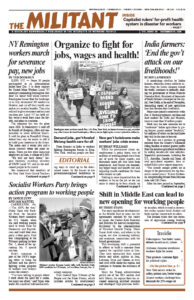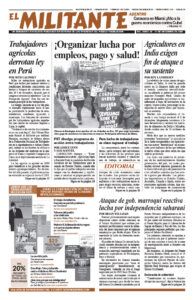While the government claims unemployment is going down, tens of millions of working people have been out of work for many months and thousands more job cuts have been announced. And bosses are demanding bigger wage and benefit cuts and imposing unsafe conditions for those who remain in a job.
Nothing is more important than for workers to be on the job so we can unite to stand up to boss attacks on wages and working conditions and build and strengthen unions to counter their assaults.

The economic, social and health crisis working people face is rooted in a worldwide long-term decline of capitalist production and trade driven by the profit crisis of the bosses, intertwined with the coronavirus pandemic.
A new spate of lockdowns is being imposed by state governors whose only answer to the rising number of overloaded hospitals is to inflict greater hardship on working people and threaten more job losses. Some 27 million people in Southern California are affected by Gov. Gavin Newsom’s latest stay-at-home order, which includes forcing thousands of workers to forego going to work.
Like lockdowns enforced earlier this year, these steps will have a devastating impact on small businesses.
But workers are finding ways to stand up to the bosses’ attacks. Nurses have organized strike actions in New Rochelle and Albany, New York, along with 700 nursing home workers in Illinois. They’re demanding more staff for safety, more pay and to put the health of patients and workers first.
Laid-off workers at the Remington firearms plant in Ilion, New York, have been rallying at the plant demanding severance pay after bosses filed for bankruptcy, slashing 585 jobs.
At Southwest Airlines, pilots, flight attendants, machinists and ramp workers are refusing to accept bosses’ demands to “trade” a 10% wage cut in “exchange” for the promise of no layoffs next year. The company announced Dec. 3 it is sending furlough warnings to 6,828 of these workers, and threatening another 402 mechanics and other workers with layoffs in January. Since March, airline companies have eliminated 82,000 jobs.
In early December the White Stallion Energy LLC and Lighthouse Resources Inc. filed for bankruptcy, eliminating over 330 miners’ jobs. These coal companies own mines in Illinois, Indiana, Montana and Wyoming.
Bosses at meatpacking giants JBS, Tyson Foods, Cargill and Smithfield Foods adopted measures they claim will prevent a repeat of the coronavirus deaths at their plants earlier this year. Workers were crammed into confined spaces to maximize line speeds and company profits. Their new steps include sending some workers home, instructing those still on the job to sit farther apart in canteens, but not spreading out work stations. That would entail building bigger facilities or slowing down line speed, something bosses consider intolerable.
More than 1 million new state and federal unemployment claims were filed for the week ending Nov. 28. Not since the pandemic began has this weekly figure been any lower.
While the official unemployment rate was 6.7% for November, 20.1 million people were receiving some form of jobless benefits as of midmonth. And this doesn’t include millions of immigrant workers without papers and part-time workers who aren’t eligible.
At the same time, those unemployed long-term continues to rise. Thirty-seven percent have been out of work for at least six months or more, according to government figures. Millions have already exhausted all jobless pay.
The number of workers with jobs in November is 9.8 million less than in February. Government statisticians consider many of these workers to have “dropped out” of the workforce. The labor-force participation rate, which measures those employed and actively seeking work, was 61.7% in October, near its lowest level since the 1970s.
Some 7 million adults, most of them women, said they weren’t working because they were stuck home caring for children as a result of school closures.
Impact of job cuts on Black workers
Job cuts by state and local governments in schools, transit systems, and libraries, and of office workers, are having a disproportionate impact on African American workers, 11.2% of whom were unemployed in November. Nearly one in six Blacks had jobs in the public sector in 2019, including jobs in public transit, sanitation, schools and in government offices. Since February, jobs of almost 1.4 million state and government workers have been eliminated.
Brandon Summers, 33, a Black resident of Nevada who is a teacher and musician, lost both jobs in March. “When one month turned into six months of no income, no employment,” he told the Financial Times, “I was reaching out for help and saying, ‘I need food … I can’t pay my rent.’”
Right now bosses are doing little to expand hiring. When they do and unemployment does drop, workers will gain more confidence, increasing possibilities for renewed and more widespread labor battles.
The Socialist Workers Party explains that workers and farmers are the only productive classes and puts forward an action program to organize against government and boss attacks.
Today, we need to fight to get workers back to work and not leave this vital question in the hands of the bosses and their government. Workers and our unions should fight for a government-financed public works program to put workers back to work at union-scale wages building and expanding schools, hospitals, day care centers and the infrastructure.
When bosses threaten more layoffs, we should demand: cut the workweek without any reduction in our weekly take-home pay. For 30 hours work at 40 hours pay!
And we need our own party, a labor party based on fighting unions that can chart a course to take political power out of the hands of the capitalist rulers and establish a workers and farmers government.


